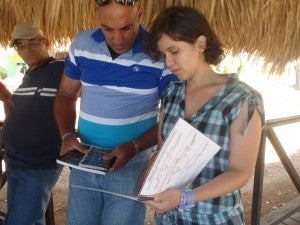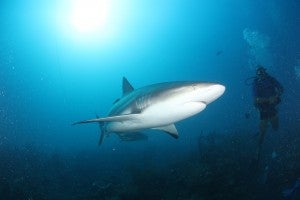Sharks are recognized by scientists, resource managers and the tourism ministry in Cuba for their critical role in marine ecosystems, as a tourist attraction for divers and as a protein source when caught by fishers. Leaders from various Cuban agencies, looking at how to balance these needs and protect sharks, are now for the first time creating a national plan for shark conservation. This is important not just for Cuba but for the entire Gulf of Mexico and Caribbean region where many shark populations travel throughout waters shared by many nations.
Earlier this year I sat in a hotel discoteca in Trinidad, Cuba that was converted into a teaching space for daytime use. Here I watched fishers jump at the chance to correctly identify shark species and prove their skills in front of their peers. This was the second shark and ray identification workshop organized by Cuba’s Ministry of Food (MINAL) and EDF where fishers, boat captains and port employees came together from across the country to learn about Cuba’s efforts to study and conserve sharks.
Because of ongoing concerns over declining shark populations in the region, the Cuban government is making shark conservation a national priority through the development of its first-ever National Plan of Action for the Conservation and Sustainable Management of Sharks and Rays (NPOA-Sharks). They hope to complete it by the end of the year.
The NPOA-Sharks is a voluntary instrument defined by the United Nation’s Food & Agriculture Organization–which encourages all member states to develop and implement. The goal of a NPOA-Sharks is to ensure the conservation and management of sharks and related species and their long-term sustainable use. Once finalized, Cuba will join 20 other countries, including the U.S. and Mexico, in creating this national framework for shark conservation. Cuba is home to dozens of species of sharks from the largest fish in the world, the whale shark, to the globally threatened, oceanic whitetip shark. Much is still unknown about Cuba’s sharks but scientists and managers have been working hard to change that and have enlisted the help of fishers to find out which sharks are more vulnerable to fishing and need greater protections.

Alejandra Briones Bell-lloch from the Office of Science and Fishing Regulations of MINAL answers fishermen’s questions using the shark identification guide.
Cuba started the process of developing the NPOA-Sharks in November 2013, and has taken proactive steps along the way to collect better information and put critical regulations in place. In January of this year, fisheries officials passed new rules to prohibit finning, and required that all sharks caught be landed whole with fins attached. This is an important step to protect sharks. Although finning isn’t currently a problem in Cuba, these regulations will ensure this doesn’t change, and will also make it easier to collect shark data in order to determine future conservation measures.
Now, after the shark identification workshops, fishers are starting to report shark catch by species. This has the potential to transform shark research and conservation because species-specific data can lead to better regulations and involving fishers in the process is key for better management long-term.
At the workshop earlier this year, some fishers were less confident than others. One pulled out their shark guide and raised concern that he still mixes up a couple sharks after trying to report his catch by species over the last year. Thankfully, shark experts from Cuba, Mexico and the U.S. were in the room to help ease his concerns. There are always some sharks that are hard to identify even with lots of training but, by working together, scientists, fishers and regulators can collect better data and find ways to ensure that sharks are around for the future.
Once implemented, the NPOA-Sharks will provide a foundation for a continual nation-wide effort to collaborate on research and conservation. NPOAs are different for each country that develops one and depends among other things on the level of information available and unique priorities and needs. In the end, developing an NPOA isn’t the hardest part, it’s ensuring that the actions outlined by the conservation plan are fulfilled and that shark populations benefit. Cuba is committed to just that and EDF and our partners are stepping up to help.
Cuban NPOA-Sharks Working Group:
- Dirección de Regulaciones Pesqueras y Ciencias, Ministerio de la Industria Alimentaria (DRPC-MINAL)
- Centro de Investigaciones Marinas, Universidad de La Habana (CIM-UH)
- Centro de Investigaciones de Ecosistemas Costeros, Ministerio de Ciencia, Tecnología y Medio Ambiente (CIEC-CITMA)
- Instituto de Oceanología, Ministerio de Ciencia, Tecnología y Medio Ambiente (IdO-CITMA)
- Centro de Investigaciones Pesqueras, Ministerio de la Industria Alimentaria (CIP-MINAL)
- Centro Nacional de Áreas Protegidas, Ministerio de Ciencia, Tecnología y Medio Ambiente (CNAP-CITMA)
- Acuario Nacional de Cuba, Ministerio de Ciencia, Tecnología y Medio Ambiente (ANC-CITMA)
- Grupo Empresarial de la Industria Alimentaria, Ministerio de la Industria Alimentaria (GEIA-MINAL)
- Ministerio del Turismo (MINTUR)
- Centro de Inspección y Control Ambiental, Ministerio de Ciencia, Tecnología y Medio Ambiente (CICA-CITMA)
- Tropas Guarda Fronteras, Ministerio del Interior (TGF-MININT)
- Empresa Nacional para la protección de la Flora y la Fauna, Ministerio de la Agricultura (ENPFF-MINAG)
Other key partners:
- Bob Hueter, Mote Marine Laboratory
- Fernando Márquez, Universidad Autónoma de Sinaloa (UAS)
- Comunidad y Biodiversidad (COBI)
- COSPE
- WWF-NL










